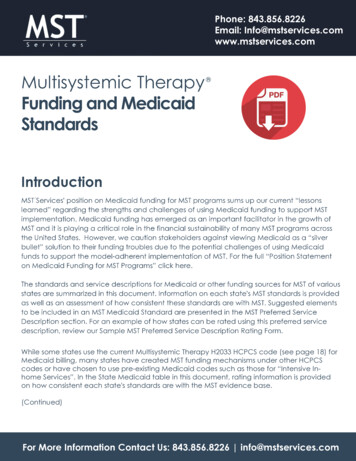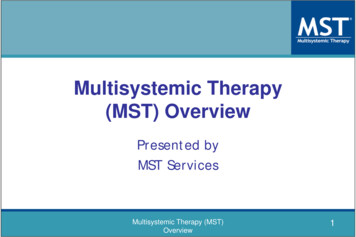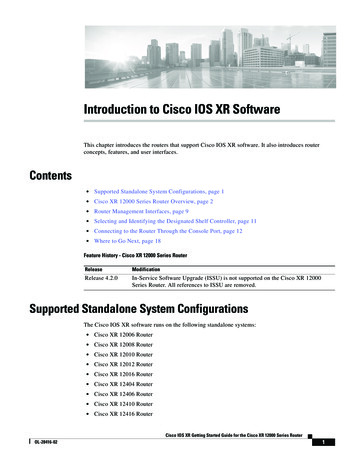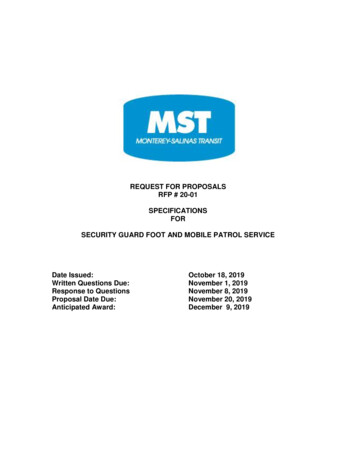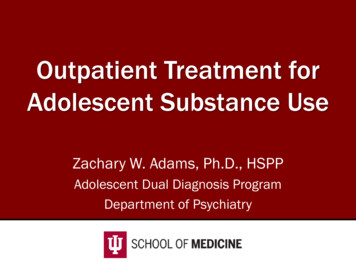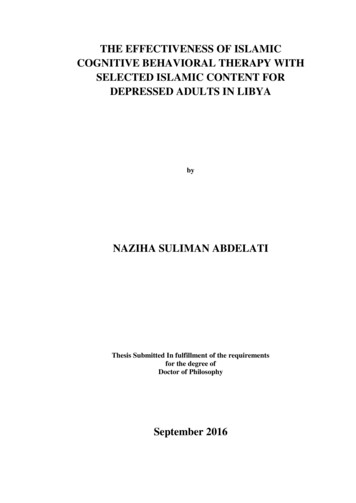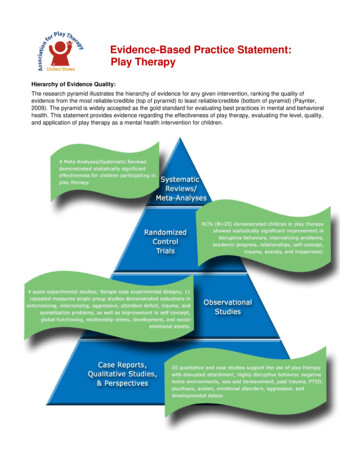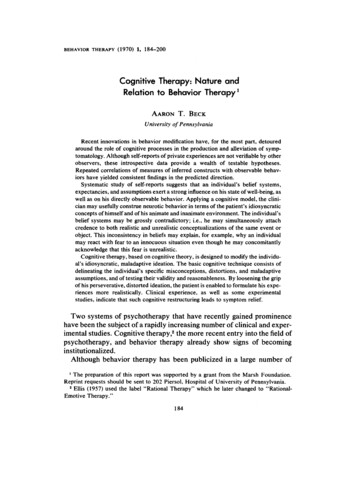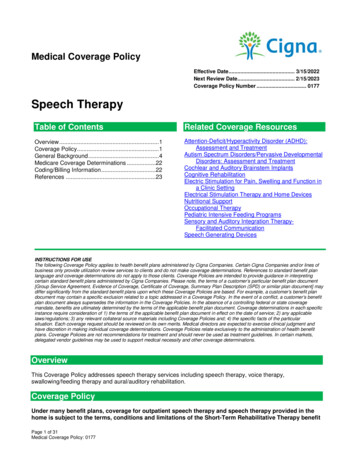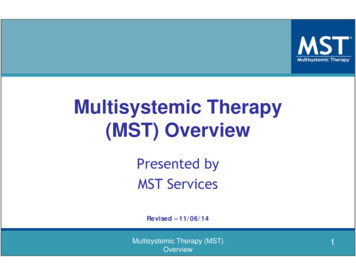
Transcription
Multisystemic Therapy(MST) OverviewPresented byMST ServicesRevised – 11/06/14Multisystemic Therapy (MST)Overview1
MST Research andDissemination Family Services Research Center (FSRC) at theMedical University of South Carolina (MUSC) MST Services MST Institute Licensed and affiliated organizations:- MST Network Partner Organizations- Local MST Provider OrganizationsMultisystemic Therapy (MST)Overview2
MST Presence Aroundthe World34 states in the US Statewide infrastructures in Connecticut, Hawaii, New Mexico, NorthCarolina, Ohio, Pennsylvania, and Louisiana15 countries AustraliaBelgiumCanadaChileDenmarkEnglandIceland Netherlands *New ZealandNorthern IrelandNorway *ScotlandSwedenSwitzerland* Nationwideinfrastructures with anemerging nationwideinfrastructure in EnglandMultisystemic Therapy (MST)Overview3
What is “MST”? Community-based, family-driven treatmentfor antisocial/delinquent behavior in youth Focus is on “Empowering” caregivers(parents) to solve current and futureproblems MST “client” is the entire ecology of theyouth - family, peers, school, neighborhood Highly structured clinical supervision andquality assurance processesMultisystemic Therapy (MST)Overview4
Standard MST Referral Criteria(ages 12-17)Inclusionary CriteriaExclusionary Criteria Youth at risk for placementdue to anti-social ordelinquent behaviors,including substance abuse Youth involved with thejuvenile justice system Youth who have committedsexual offenses inconjunction with other antisocial behavior Youth living independently Sex offending in the absence of otheranti social behavior Youth with moderate to severe autism(difficulties with social communication, socialinteraction, and repetitive behaviors) Actively homicidal, suicidal or psychotic Youth whose psychiatric problems areprimary reason leading to referral, orhave severe and serious psychiatricproblemsMultisystemic Therapy (MST)Overview5
Families as the Solution MST focuses on families as the solution Families are full collaborators in treatmentplanning and delivery with a focus on familymembers as the long-term change agents Giving up on families, or labeling them as“resistant” or “unmotivated” is not an option MST has a strong track record of clientengagement, retention, and satisfactionMultisystemic Therapy (MST)Overview6
MST “Champions” & Advocates U.S. Surgeon General: Reports on Mental Healthand Youth ViolenceNational Institutes on Health (NIH)U.S. Department of Justice - OJJDPNational Institute on Drug Abuse (NIDA),Center forSubstance Abuse Treatment (CSAT), and Center forSubstance Abuse Prevention (CSAP)Washington State Institute for Public Policy (WSIPP)“Blueprints for Violence Prevention”Multisystemic Therapy (MST)Overview7
Surgeon General’s Reports MST is the only treatment to qualify for inclusionin the Surgeon General’s Report on Mental Healthunder Home-Based Services.(Mental Health: A Report of the Surgeon General, 1999) MST is highlighted in the Surgeon General’s Reporton Youth Violence as an effective treatmentprogram for adolescent criminal offenders(Youth Violence: A Report of the Surgeon General, 2001)Multisystemic Therapy (MST)Overview8
US Department of Justice - OJJDP MST offers new hope to young people withserious behavioral disorders. MST has demonstrated decreased criminalactivity and incarceration in studies withviolent and chronic juvenile offenders, andresults are promising in studies of otherpopulations that present complex clinicalproblems. (OJJDP Bulletin, 1997)Multisystemic Therapy (MST)Overview9
Preventing Violence. in Adolescents:National Institutes of Health State-of-theScience Conference Multisystemic Therapy. evaluations havedemonstrated reductions in long-term rates ofrearrest, violent crime arrest, and out-ofhome placements. Positive results weremaintained for nearly 4 years after treatmentended.(NIH Preventing Violence State-of-the-ScienceConference Statement, 2005)Multisystemic Therapy (MST)Overview10
MST and Substance Abuse Services National Institute of Drug Abuse– Highlights MST as an effective research-basedtreatment program (Principles of Drug AddictionTreatment: A Research-Based Guide, NIDA, 1999) Center of Substance Abuse Prevention– 2000 Exemplary Substance Abuse Prevention Award Center of Substance Abuse Treatment– Identified as a strategy for integrating SubstanceAbuse Treatment into the Juvenile Justice SystemMultisystemic Therapy (MST)Overview11
Cost Effectiveness of MST Washington State Institute for Public Policy (2011)– Evaluating “evidence-based” options to reduce thefuture need for prison beds, save money, and lowercrime rates.– Estimated net taxpayers benefits for using MST inlieu of placement: 29,302/youth– Benefits of 4.07 for every 1.00 invested in MSTimplementationMultisystemic Therapy (MST)Overview12
Blueprints ForViolence Prevention Objective: find programs to form the nucleus of anational violence prevention initiative – 11 programshave been selected to date Selection standards: strong research design, evidenceof significant deterrence effects, multi-sitereplication, and sustained effects. Comprehensive review of more that 900 programs -MST is a Blueprint for serious, violent and/orsubstance abusing youthMultisystemic Therapy (MST)Overview13
How Does MST Work?Key Points: Theoretical And Research Underpinnings MST Theory of Change and Assumptions How is MST Implemented?Multisystemic Therapy (MST)Overview14
Theoretical UnderpinningsBased on social ecological theory ofUri Bronfenbrenner Children and adolescents live in a socialecology of interconnected systems that impacttheir behaviors in direct and indirect ways These influences act in both directions(they are reciprocal and bi-directional)Multisystemic Therapy (MST)Overview15
Social Ecological ModelCommunityProvider AgencySchoolNeighborhoodPeersExtended emic Therapy (MST)Overview16
Causal Models of Delinquency and DrugUse: Common Findings of 50 Years ofResearchFamilyPrior rSchoolNeighborhood/ CommunityContextMultisystemic Therapy (MST)Overview17
Research on Delinquencyand Drug UseFamily Level Poor parental supervision Inconsistent or lax discipline Poor affective relations between youth,caregivers, and siblings Parental substance abuse and mental healthproblemsMultisystemic Therapy (MST)Overview18
Research on Delinquencyand Drug Use (Cont.)Peer Level Association with drug-using and/or delinquentpeers Poor relationship with peers, peer rejection Association with antisocial peers is the mostpowerful direct predictor of delinquentbehavior!Multisystemic Therapy (MST)Overview19
Research on Delinquencyand Drug Use (Cont.)School Level Academic difficulties, low grades, having beenretained Behavioral problems at school, truancy,suspensions Negative attitude toward school Attending a school that does not flex to youthneedsMultisystemic Therapy (MST)Overview20
Research on Delinquencyand Drug Use (Cont.)Community Level Availability of weapons and drugs High environmental and psychosocial stress(violence) Neighborhood transience – neighbors move inand outMultisystemic Therapy (MST)Overview21
Research on Delinquencyand Drug Use (Cont.)Youth Level ADHD, impulsivity Positive attitude toward delinquency andsubstance use Lack of guilt for transgressions Negative affectMultisystemic Therapy (MST)Overview22
MST Theory of edAntisocialBehavior andImprovedFunctioningCommunityMultisystemic Therapy (MST)Overview23
MST Assumptions Children’s behavior is strongly influenced by theirfamilies, friends and communities (and viceversa) Families and communities are central andessential partners and collaborators in MSTtreatment Caregivers/parents want the best for theirchildren and want them to grow to becomeproductive adultsMultisystemic Therapy (MST)Overview24
MST Assumptions (Cont.) Families can live successfully without formal,mandated services Change can occur quickly Professional treatment providers should beaccountable for achieving outcomes Science/research provides valuable guidanceMultisystemic Therapy (MST)Overview25
How is MST Implemented?Intervention strategies: MST draws fromresearch-based treatment techniques Behavior therapyParent management trainingCognitive behavior therapyPragmatic family therapies- Structural Family Therapy- Strategic Family Therapy Pharmacological interventions (e.g., for ADHD)Multisystemic Therapy (MST)Overview26
How is MST Implemented?(Cont.) Single therapist working intensively with 4 to 6families at a time Team of 2 to 4 therapists plus a supervisor 24 hr/ 7 day/ week team availability: on callsystem 3 to 5 months is the typical treatment time (4months on average across cases) Work is done in the community, home, school,neighborhood: removes barriers to service accessMultisystemic Therapy (MST)Overview27
How is MST Implemented?(Cont.) MST staff deliver all treatment – typically no or fewservices are brokered/referred outside the MST team Never-ending focus on engagement and alignment withprimary caregiver and other key stakeholders (e.g.probation, courts, children and family services, etc.) MST has strong track record of client retention andsatisfaction with MST MST staff must be able to have a “lead” clinical role,ensuring services are individualized to strengths andneeds of each youth/familyMultisystemic Therapy (MST)Overview28
Quality Assurance and ContinuousQuality Improvement in MSTGoal of MST Implementation: Obtain positive outcomes for MST youth and their familiesQA/QI Process: Training and ongoing support (orientation training,boosters, weekly expert consultation, weekly supervision)Organizational support for MST programsImplementation monitoring (measure adherence andoutcomes, work sample reviews)Improve MST implementation as needed, using feedbackfrom training, ongoing support, and measurementMultisystemic Therapy (MST)Overview29
QA/QI Process:Training and Support Training and support to help therapists, supervisors, andexperts implement the model as designed– Training processes (5-day Orientation, Supervisor Orientation,Boosters, Consultation, Group Supervision, and additionalsupervision and feedback for all staff as needed)– Training materials (MST text, 5-day training materials,Supervisory Manual, Supervisor Orientation materials, andConsultation Manual)Multisystemic Therapy (MST)Overview30
QA/QI Process:Organizational Support for MSTPrograms Training resources and materials in organizationalpractices that support MST– Program Developer Training– Organizational Manual Implement organizational practices needed to supportdelivery of the treatment model– MST Program Development Method– Ongoing problem solving of organizational and stakeholderbarriers to implementationMultisystemic Therapy (MST)Overview31
QA/QI Process: MonitorImplementation of the Model Measure Adherence to the Model– Adherence measures entered and monitored via theMSTI Website (TAM-R, SAM, CAM, Program ReviewForm)– Work sample review (e.g. session recordings and fieldvisits, group supervision recordings) Measure Outcomes―Discharge Review Form data entered and monitoredvia the MSTI WebsiteMST Therapists' Role in ContinuousQuality Improvement32
QA/QI Process:Improve Implementationof MST as Needed Improve implementation as needed, based on theinformation provided via measurement of adherence,outcomes, and staff’s strengths and needs– Group supervision, consultation, and additional supervisionand feedback as needed– Program Implementation Review– Professional development planning Follow an ongoing cycle of utilizing trainings andmaterials to guide implementation, measuring, andimproving implementation33
PIRMST QA/QI OverviewProgramImplementationReview and otherreportsInput/feedback via internet‐based data collectionTraining/support, including MST manuals/materialsOutput to –Organization, Program Stakeholders andMST CoachOrganizational ContextMSTCoachMST ceMeasureOutput to –MST ut to –MST ut to –MST Supervisor and MST Expert
MST Quality Assurance SystemResearch-based adherence measures: TAM – youth criminal charges 36% lower for families withmaximum adherence score (1) than for families withminimum adherence score (0) SAM – youth criminal charges 53% lower for families withmaximum SAMSP score (1) than for families with minimumSAMSP score (0) CAM – consultant/MST expert adherence predicts improvedtherapist adherence and improved youth outcomesMultisystemic Therapy (MST)Overview
MST Transportability Study:Relationship between TAM-R and YouthCriminal Outcomes (2.3 year follow-up)TAM-R Predicting Post-Treatment Criminal ChargesNumber of Post-Treatment Charges2.50 (Min.)2.32.10.38 (-1 SD)1.90.64 (Mean)1.70.92 ( 1 SD)1 (Max.)1.51.30 (Min.)0.10.20.30.40.50.60.7TAM-R ScoreMultisystemic Therapy (MST)Overview0.80.91 (Max.)
MST Transportability Study:Relationship between SAM and Youth CriminalOutcomes (2.3 year follow-up)SAM Structure & Process Predicting Post-Treatment Criminal Charges4Number of Post-Treatment Charges0 (Min.)3.532.50.66 (-1 SD)0.76 (Mean)0.86 ( 1 SD)21 (Max.)1.510 (Min.)0.10.20.30.40.50.6Supervisor SAMSPMultisystemic Therapy (MST)Overview0.70.80.91 (Max.)
Core Elements of MSTKey Points: MST Treatment Principles MST Analytic Process MST Quality Assurance SystemMultisystemic Therapy (MST)Overview38
MST Treatment Principles Nine principles of MST intervention designand implementation Treatment fidelity and adherence ismeasured with relation to these nineprinciplesMultisystemic Therapy (MST)Overview39
9 Principles of MST1.2.3.4.5.6.7.8.9.Finding the FitPositive and Strength FocusedIncreasing ResponsibilityPresent-focused, Action-Oriented & Well-DefinedTargeting SequencesDevelopmentally AppropriateContinuous EffortEvaluation & AccountabilityGeneralization
1. Finding the Fit:The primary purpose of assessment is to understandthe “fit” between the identified problems and their broadersystemic contextLowmonitoringby motherModeling of use incommunity (peersand adults)Boredom, doesn’thave other thingsto doDrug usingPeersKim’sSubstanceAbuseLack ofconsequencesfor useAccess tomarijuanaKim can buydrugs with cashgiven to her byrelativesUses afterconflicts withmother41
Principles of MST (Cont.)2. Positive & Strength FocusedTherapeutic contacts should emphasize thepositive and should use systemic strengths aslevers for change.Multisystemic Therapy (MST)Overview42
Principles of MST (Cont.)3. Increasing ResponsibilityInterventions should be designed to promoteresponsibility and decrease irresponsible behavior amongfamily members.4. Present-focused, Action-oriented & Well-definedInterventions should be present-focused and actionoriented, targeting specific and well-defined problems.Multisystemic Therapy (MST)Overview43
5. Targeting Sequences: Interventionsshould target sequences of behavior within and betweenmultiple systems that maintain identified problems (cont.)Mom asks youthto dohomework andclean roomStep fatherstarts shouting:“you live in myhouse, do itnow”Mom gets in themiddle to stopverbalargument andgets pushedYouth says he’lldo it in aminuteYouth states“get out of myface, you’renot my dad”Mom hits herhead, stepfather isfuriousMom makes asecondrequest; youthignoresStep-fatherintervenes:“listen to yourmom”Youth runs toroom, and locksdoorYouth arrestedfor assaultchargeStep-fathercalls police44
Principles of MST (Cont.)6.Developmentally AppropriateInterventions should be developmentallyappropriate and fit the developmental needs ofthe youth.Multisystemic Therapy (MST)Overview45
Principles of MST (Cont.)7. Continuous EffortInterventions should be designed to require dailyor weekly effort by family members.8. Evaluation and AccountabilityIntervention efficacy is evaluated continuouslyfrom multiple perspectives, with providersassuming accountability for overcoming barriersto successful outcomes.Multisystemic Therapy (MST)Overview46
Principles of MST (Cont.)9. GeneralizationInterventions should be designed to promotetreatment generalization and long-termmaintenance of therapeutic change byempowering care givers to address familymembers’ needs across multiple systemiccontexts.Multisystemic Therapy (MST)Overview47
MSTAnalyticalProcessReferralBehaviorDesired Outcomesof Family and Othery ParticipantspKeyOverarchingGoalsEnvironment of Alignment and Engagementof Family and Key ParticipantsMST Conceptualizationof “Fit”Re-evaluatePrioritizeAssessment ofAdvances & Barriers toIntervention ermediaryGoalsDoInterventionDevelopment48
MST’s Research HeritageKey Points: 30 years of Science Consistent Outcomes Transportability Study Findings Role of Model AdherenceMultisystemic Therapy (MST)Overview49
MST: 30 Years of Science32 published outcome, transportability and benchmarking studiesincluding 22 randomized trials 15 studies using standard MST with juvenile offenders- 7 independent studies 2 studies with substance-abusing or –dependent juvenile offenders (MST-SubstanceAbuse) 3 studies with juvenile sexual offenders(MST-Problem Sexual Behavior) 3 studies with youths presenting serious emotional disturbances(MST-Psychiatric) 2 studies with maltreating families (MST-Child Abuse and Neglect) 4 studies with adolescents with chronic health care conditions (MST-Health Care)– Diabetes and obesity 3 large-scale transportability (implementation) studies* Complete list of MST outcome studies: c Therapy (MST)Overview50
Consistent OutcomesIn Comparison with Control Groups, MST: Led to higher consumer satisfaction Decreased long-term rates of re-arrest 25% to 70% 47% to 64% decreases in long-term rates of days in out-of-homeplacements Improved family relations and functioning Increased mainstream school attendance and performance Decreased adolescent psychiatric symptoms Decreased adolescent substance useBut, none of this happens without adherence to MSTMultisystemic Therapy (MST)Overview51
Long-term Outcomes14-year and 22-year post-treatment outcomes(MST compared to Individual Treatment: individuals treated 1983-1986)14 years post treatment(n 165, 94% tracking success) 54% fewer arrests 59% fewer violent arrests 64% fewer drug-related arrests 57%fewer days in adultconfinement 43% fewer days on adultprobation22 years post treatment(n 148, 84% tracking success) 36% fewer felony arrests 75% fewer violent felony arrests 33% fewer days in adult confinement 38% fewer issues with family instability(divorce, paternity, child support suits) 3% fewer financial problems(credit, contract, rent suits)Multisystemic Therapy (MST)Overview52
MST Ultimate Outcomes2014 MSTI Data ReportAT HOMEIN SCHOOL/WORKINGNO ARRESTSThese results are based on a89% comprehensive review of the12,127 cases (85.9% of14,123 cases referred fortreatment in 2013) that were84%closed for clinical reasons(i.e., completed treatment,low engagement, or placed).85%Multisystemic Therapy (MST)Overview53
The Missouri Delinquency ProjectCharles M. Borduin, (PI), University of MissouriBarton J. Mann, University of Illinois - ChicagoLynn T. Cone, University of MissouriScott W. Henggeler, Medical University of South CarolinaBethany R. Fucci, University of MissouriDavid M. Blaske, University of MissouriRobert A. Williams, University of MissouriMultisystemic Therapy (MST)Overview54
Participants:200 Offenders and Their Families Averaged 4.2 previous arrests 64% had been incarcerated previously for atleast 4 weeks Average age 14.8 years 67% male, 33% female 30% African-American, 70% Caucasian 47% lived with only one parental figureMultisystemic Therapy (MST)Overview55
Service/Treatment Options Multisystemic Therapy– 77 completers– 15 dropouts Individual Therapy– 63 completers– 21 dropouts Usual probation services for refusers– 24 refusersMultisystemic Therapy (MST)Overview56
Instrumental Outcomes at Post-treatmentMultisystemic Therapy was significantlymore effective at: Increasing family cohesion andadaptability Increasing family supportiveness Decreasing family hostility Decreasing parental symptomatology Decreasing behavior problems in youthMultisystemic Therapy (MST)Overview57
Ultimate Outcomes atFive-Year Follow-UpMultisystemic Therapy was significantlymore effective at: Preventing violent offendingPreventing other criminal offendingPreventing drug-related offendingDecreasing seriousness of committedcrimesMultisystemic Therapy (MST)Overview58
Missouri Delinquency Project100%MSTCompletersPercent of OffendersNot Re-Arrested90%80%70%MSTDropouts60%50%40%IT Completers30%20%IT rs Past Treatment TerminationMultisystemic Therapy (MST)Overview59
The Missouri Delinquency ProjectLong-term (14 year) follow-up StudySchaeffer, C.M., and Borduin, C.M. (2005)Multisystemic Therapy (MST)Overview60
14-Year Follow-Up Sample Attempted to locate all participants (N 176)who were randomly assigned to MST or individualtherapy in Borduin et al. (1995) clinical trial Successfully located 165 (94%) of the originalparticipants Average age at follow-up: 28.8 years (range 24to 32 years) Outcomes examined: criminal recidivism, daysincarcerated and on probation in adulthoodMultisystemic Therapy (MST)Overview61
All Arrests 14-Year Follow-Up3.961.8254%reductionMSTIndividual TherapyMultisystemic Therapy (MST)Overview62
Violent Arrests 14-Year Follow-Up.51.2159%reductionMSTIndividual TherapyMultisystemic Therapy (MST)Overview63
Drug-Related Arrests 14-Year Follow-Up64%reduction.55.20MSTIndividual TherapyMultisystemic Therapy (MST)Overview64
Adult Days Confined1357 days/3.72 years 14-Year Follow Up582 days/1.59 years57%reductionMSTIndividual TherapyMultisystemic Therapy (MST)Overview65
Adult Days on Probation 14-Year Follow Up739 days/2.02 years421 days/1.15 years43%reductionMSTIndividual TherapyMultisystemic Therapy (MST)Overview66
The Missouri Delinquency ProjectLong-term (22 year) follow-up StudySawyer, A. M., & Borduin, C. M. (2011)Multisystemic Therapy (MST)Overview67
Unique Aspects of22-Year Follow-Up Longest follow-up of an evidence-basedtreatment ever conducted One of the longest follow-ups of anyrandomized trial ever conducted Examined civil court outcomes as wellas criminal outcomesMultisystemic Therapy (MST)Overview68
22-Year Follow-Up Sample Attempted to locate all participants (N 176) whowere randomly assigned to MST or individual therapyin Borduin et al. (1995) clinical trial Located 148 (84%) of the original participants Average age at follow-up: 37.7 years (range ?) Criminal outcomes: convictions for felony,misdemeanor, violent, and nonviolent crimes;incarceration Civil Court outcomes: divorce, paternity suits, childsupport suits, account/credit, contract, and rent suitsMultisystemic Therapy (MST)Overview69
Any Felony Arrests 22-Year Follow-Up55%35%36%reductionMSTIndividual TherapyMultisystemic Therapy (MST)Overview70
Violent Felony Arrests 22-Year Follow-Up75%reduction16%4%MSTIndividual TherapyMultisystemic Therapy (MST)Overview71
Nonviolent Felony Arrests 22-Year Follow-Up51%35%33%reductionMSTIndividual TherapyMultisystemic Therapy (MST)Overview72
Incarceration Years 22 Year Follow Up7.88 years5.25 years33%reductionMSTIndividual TherapyMultisystemic Therapy (MST)Overview73
Family instability: divorce,paternity suits, child support suits 22-Year Follow Up48%30%38%reductionMSTIndividual TherapyMultisystemic Therapy (MST)Overview74
Multisystemic Therapy For SeriousJuvenile Offenders – The SimpsonvilleStudyScott W. HenggelerGary B. MeltonFunded by NIMHMultisystemic Therapy (MST)Overview75
Simpsonville Study:84 Serious Juvenile Offenders All at “imminent risk” of out-of-home placement 54% were violent offenders– manslaughter (2), assault and battery withintent to kill (3), aggravated assault (9) Averaged 3.5 previous criminal arrestAveraged 9.5 weeks of prior incarcerationAverage age was 15.2 years, 77% males56% African-American, 42% CaucasianMultisystemic Therapy (MST)Overview76
Simpsonville Study:Project Goals Reduce rates of criminal activityReduce cost of servicesReduce time in out-of-home placementPreserve family integrityMultisystemic Therapy (MST)Overview77
Needs of Violentand Chronic JuvenileOffenders and Their Families Improve parental discipline practicesIncrease family affectionDecrease association with deviant peersIncrease association with prosocial peersImprove school/vocational performanceEngage in positive recreational activitiesImprove family-community relationsEmpower family to solve future difficultiesMultisystemic Therapy (MST)Overview78
Simpsonville Study Results Multisystemic Therapy was more effective thanusual services in meeting each goalMultisystemic Therapy (MST)Overview79
Simpsonville Study:Arrests1.52 59 Week Follow-up.8756%reductionMSTUsual ServicesMultisystemic Therapy (MST)Overview80
Simpsonville Study:Self-Reported Offenses 59 Week Follow-up66%reduction8.62.9MSTUsual ServicesMultisystemic Therapy (MST)Overview81
Simpsonville Study:Time in Out-of-Home Placements16.2weeks 59 Week Follow-up5.8 weeks64%reductionMSTUsual ServicesMultisystemic Therapy (MST)Overview82
Simpsonville Study:Cost of Services (1992 dollars) 20,000 59 Week Follow-up 8,000*60%reduction* 4,000 for MST & 4,000 for PlacementsMSTUsual ServicesMultisystemic Therapy (MST)Overview83
Not Re-ArrestedPercentage of OffendersSimpsonville Study:2.4 Year Services00.40.81.21.5Years Post TreatmentMultisystemic Therapy (MST)Overview22.484
An Independent Effectiveness Trial of MSTwith Juvenile Justice Youth –The Ohio Replication StudyJane Timmons-MitchellMonica B. Bender, Maureen A. Kishna andClare C. MitchellFunded by the Ohio Office of Criminal Justice ServicesMultisystemic Therapy (MST)Overview85
Ohio IndependentReplication TrialIndependent effectiveness trial of105 youth offenders: averaged age of 15 yearsaveraged approximately sevenprior offenseswere predominantly male (78%)and white (78%)Multisystemic Therapy (MST)Overview86
Ohio IndependentReplication TrialResults for the MST group 2 years after completion:– 23% less likely to be re-arrested (67% of theMST group had been re-arrested at least once,versus 87% of the control group).– 39% fewer arrests and arraignments per youthover the two years (1.4 vs. 2.3)– significant improved functioning for MST groupin the home, at school and in the community.Multisystemic Therapy (MST)Overview87
Ohio IndependentReplication Study Quality High quality replication conducted by independentresearchers (i.e. not the program's developers). Low attrition: At the 2-year follow-up, outcome data onarrest rates were collected for 89% of the originalsample Conducted in a community mental health settingproviding evidence of its real-world effectiveness Used official arrest data to measure criminal behaviorMultisystemic Therapy (MST)Overview88
MST Transportability StudySonja K. SchoenwaldFunded by NIMH and NIDAMultisystemic Therapy (MST)Overview89
Social Ecological Modelof Treatment TransportabilityExtra-Organizational Context(Referral, Reimbursement, ianAdherenceChildOutcomesMST SupervisionClinician VariablesProfessional Training & ExperienceMultisystemic Therapy (MST)Overview
Transportability StudyParticipants 45 MST programs in 12 states and Canada 453 clinicians (therapists and supervisors) 1979 youths and their primary caregiversMultisystemic Therapy (MST)Overview91
Transportability Study Participants 45 MST programs in 12 states and Canada 453 clinicians (therapists and supervisors)— 64% women— 66% Caucasian; 11 % African American; 5% Asian or PacificIslander, 2% Hispanic, 21% other and mixed race or ethnicity— Average age of 34.3 years (SD 9.4; range 23-66 years old)— Majority (54%) held Master’s degree; 32% held Bachelor’sdegree— Most common degree fields: social work, psychology,counselingMultisystemic Therapy (MST)Overview
Transportability Study Participants 1979 youths and their primary caregivers— Youths were on average 14.6 years old (SD 2.32), and(65.2%) were male— Racial/ethnic identification: 57.8% Caucasian; 18.6% AfricanAmerican; 5.8% Asian or Pacific Islander; 4.2% Hispanic, 13.1%Mixed and Other— Referred to MST by: Juvenile Justice (44.6%); Child Welfare(22.5%), Mental Health (17.5%); Education & Other (15.1%)— Top 3 referral reasons: Criminal offenses, status offenses,substance abuse.Multisystemic Therapy (MST)Overview
MST Transportability StudyOutcomes Summary 1-year post-treatment reductions in youthbehavior problems and functioning Over 2-year post-treatment reductions incriminal activityMultisystemic Therapy (MST)Overview94
Transportability ResearchFindings on AdherenceResearch-based adherence measures TAM (Therapist Adherence Measure)– youth criminal charges36% lower for families with maximum adherence score (1) thanfor families with minimum adherence score (0) SAM (Supervisor Adherence Measure) – youth criminal charges53% lower for families with maximum SAMSP score (1) than forfamilies with minimum SAMSP score (0) CAM (Consultant Adherence Measure)– consultant/MST expertadherence predicts improved therapist adherence and improvedyouth outcome
Parent management training Cognitive behavior therapy Pragmatic family therapies - Structural Family Therapy - Strategic Family Therapy Pharmacological interventions (e.g., for ADHD) Multisystemic Therapy (MST) Overview 26
